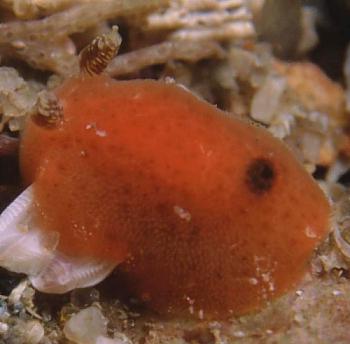

Rostanga arbutus
(Angas, 1864)
Order: NUDIBRANCHIA
Suborder: DORIDINA
Family: Dorididae
DISTRIBUTION
Previously thought to be widely spread throughout Australia and the Indo-West Pacific but now known to occur only in New South Wales, eastern Australia.
PHOTO
UPPER: Feeding on sponge, Clathria aceratoobtusa (Microcionidae), Long Reef, Sydney, New South Wales, Australia. August 1986. LOWER: Bright red colour form on sponge. Coffs Harbour region, New South Wales, Australia. December 1990. AM C164554. PHOTOS: Bill Rudman
RELATED TOPIC
Defensive colouration in sea slugs
See also R. arbutus - Radula.
See also R. arbutus - Anatomy.
This species is often found crawling over rocks and algae but even though it is very conspicuous, its shape and texture makes it easily mistaken for a small patch of inedible distasteful sponge. Most species of Rostanga feed on orange or reddish-orange sponges, and they appear to retain the sponge's colour pigments in their skin to give them an almost perfect colour match with their food.
The mantle is orange-red with a close covering of colourless translucent caryophyllidia. On the basal mantle epidermis is a scattering of dark brown specks and patches, the density of brown markings varying in different specimens. In some specimens there is some white pigmentation between the rhinophores, and in most animals large whitish mantle glands are clearly visible forming a submarginal row around the mantle. Each large gland is usually surrounded by small white specks and sometimes small white secondary glands. The rhinophore stalk is translucent clear and the club is dark-brown to black with some white specks on the lamellae. The terminal knob on the rhinophore club is a translucent straw colour. The gills are watery orange with some brown dusting. The mantle is ovate and the visceral hump between the gills and rhinophores appears more raised in stationary than in moving specimens. The mantle is densely covered with caryophyllidia. The rhinophore stalk is short and inflated, and the ovate club has approximately ten lamellae arranged almost horizontally, with only a slight downward slope posteriorly. There is a rounded terminal knob to the rhinophore club. There are approximately 12 gills arranged in a close upright circle around the anal papilla. Each gill is tripinnate but the pinnules are relatively short with few secondary branches. Towards the tip of each gill the pinnules become progressively shorter to produce a rounded tip so that the complete gill circlet has a crenulate edge.
The egg ribbon consists of a thick rigid jelly containing a coiled string of large bright orange eggs. It consists of one to two and one half coils. The embryos pass through a reduced veliger stage with a cap-shaped shell before hatching as benthic juveniles fourteen or fifteen days after oviposition.
It is found at low tide on rock platforms crawling over rock and algal turf in the upper eulittoral zone and is often in association with an encrusting bright red poecilosclerid sponge Clathria (Ophlitaspongia) aceratoobtusa (Carter, 1887) (Fam: Microcionidae).
Reference:
• Rudman, W.B., Avern, G. (1989) The genus Rostanga (Nudibranchia: Dorididae) in the Indo-West Pacific. Zoological Journal of the Linnean Society 96(3): 281-338.
Rudman, W.B., 2002 (February 5) Rostanga arbutus (Angas, 1864). [In] Sea Slug Forum. Australian Museum, Sydney. Available from http://www.seaslugforum.net/find/rostarbu
Related messages
Rostanga arbutus from Sydney
March 19, 2001
From: Erik Schloegl

Dear Bill,
Here's another (more recent) shot from Camp Cove, Sydney Harbour. It was taken on February 19, 2001. The depth was 6m, the water temperature 22 C. Given your reply to my previous message, I think this may be a juvenile Trippa intecta - it was only about 5mm long. Have I learned something here or do I need to do some more homework?
Best regards,
Erik
Erik.Schlogl@uts.edu.au
Schloegl, E., 2001 (Mar 19) Rostanga arbutus from Sydney. [Message in] Sea Slug Forum. Australian Museum, Sydney. Available from http://www.seaslugforum.net/find/3990Dear Erik,
Like Trippa ornata this animal does have spiky tubercles or papillae on its mantle but they are a bit different. Your photo is of Rostanga arbutus. Both species of Rostanga and Jorunna [see Jorunna pantherina] have spiculate tubercles called caryophyllidia which have a ring of glass-like spicules which project from the skin of each tubercle, giving the whole mantle a rough 'furry' appearance and feel.
Best wishes,
Bill Rudman
